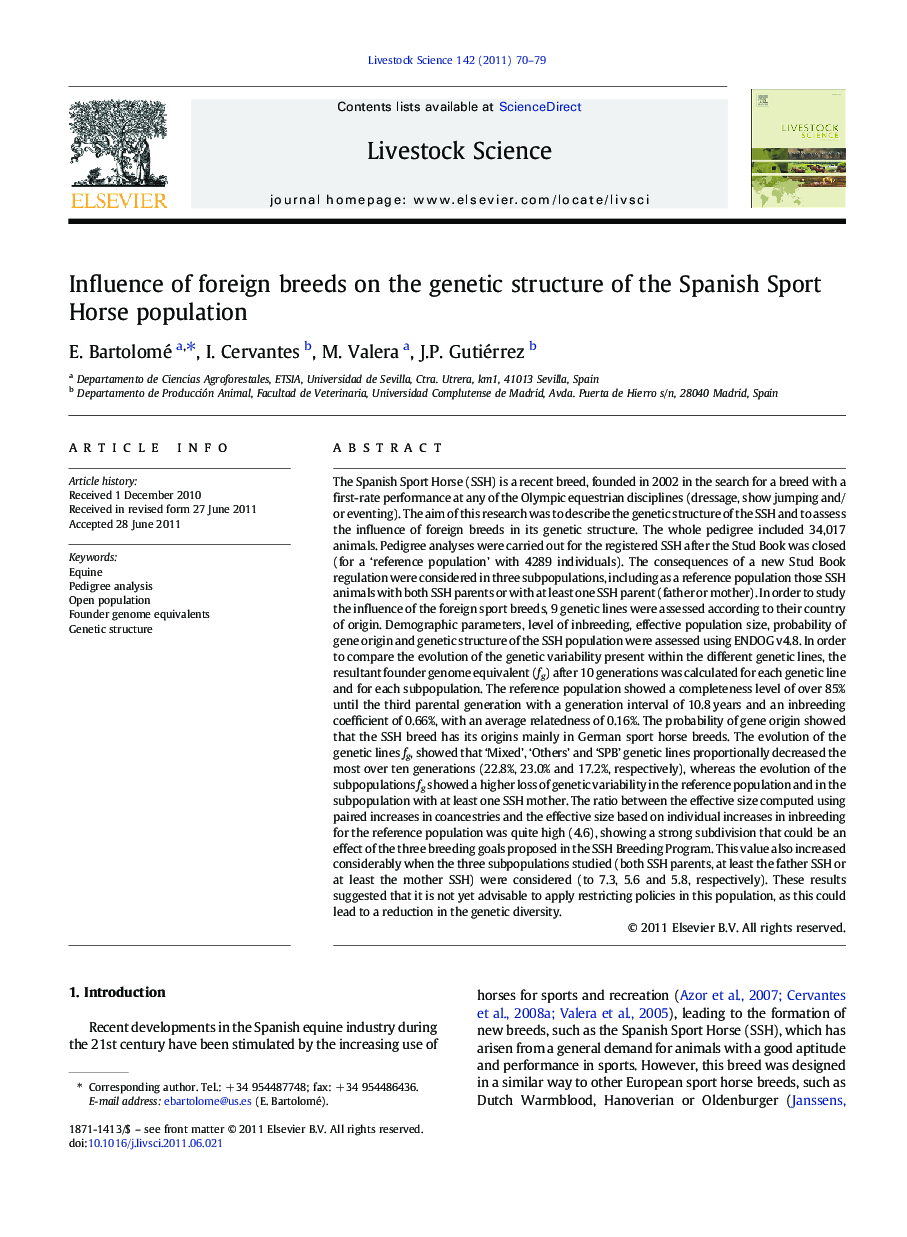| کد مقاله | کد نشریه | سال انتشار | مقاله انگلیسی | نسخه تمام متن |
|---|---|---|---|---|
| 5790737 | 1553990 | 2011 | 10 صفحه PDF | دانلود رایگان |
عنوان انگلیسی مقاله ISI
Influence of foreign breeds on the genetic structure of the Spanish Sport Horse population
دانلود مقاله + سفارش ترجمه
دانلود مقاله ISI انگلیسی
رایگان برای ایرانیان
کلمات کلیدی
موضوعات مرتبط
علوم زیستی و بیوفناوری
علوم کشاورزی و بیولوژیک
علوم دامی و جانورشناسی
پیش نمایش صفحه اول مقاله

چکیده انگلیسی
The Spanish Sport Horse (SSH) is a recent breed, founded in 2002 in the search for a breed with a first-rate performance at any of the Olympic equestrian disciplines (dressage, show jumping and/or eventing). The aim of this research was to describe the genetic structure of the SSH and to assess the influence of foreign breeds in its genetic structure. The whole pedigree included 34,017 animals. Pedigree analyses were carried out for the registered SSH after the Stud Book was closed (for a 'reference population' with 4289 individuals). The consequences of a new Stud Book regulation were considered in three subpopulations, including as a reference population those SSH animals with both SSH parents or with at least one SSH parent (father or mother). In order to study the influence of the foreign sport breeds, 9 genetic lines were assessed according to their country of origin. Demographic parameters, level of inbreeding, effective population size, probability of gene origin and genetic structure of the SSH population were assessed using ENDOG v4.8. In order to compare the evolution of the genetic variability present within the different genetic lines, the resultant founder genome equivalent (fg) after 10 generations was calculated for each genetic line and for each subpopulation. The reference population showed a completeness level of over 85% until the third parental generation with a generation interval of 10.8Â years and an inbreeding coefficient of 0.66%, with an average relatedness of 0.16%. The probability of gene origin showed that the SSH breed has its origins mainly in German sport horse breeds. The evolution of the genetic lines fg, showed that 'Mixed', 'Others' and 'SPB' genetic lines proportionally decreased the most over ten generations (22.8%, 23.0% and 17.2%, respectively), whereas the evolution of the subpopulations fg showed a higher loss of genetic variability in the reference population and in the subpopulation with at least one SSH mother. The ratio between the effective size computed using paired increases in coancestries and the effective size based on individual increases in inbreeding for the reference population was quite high (4.6), showing a strong subdivision that could be an effect of the three breeding goals proposed in the SSH Breeding Program. This value also increased considerably when the three subpopulations studied (both SSH parents, at least the father SSH or at least the mother SSH) were considered (to 7.3, 5.6 and 5.8, respectively). These results suggested that it is not yet advisable to apply restricting policies in this population, as this could lead to a reduction in the genetic diversity.
ناشر
Database: Elsevier - ScienceDirect (ساینس دایرکت)
Journal: Livestock Science - Volume 142, Issues 1â3, December 2011, Pages 70-79
Journal: Livestock Science - Volume 142, Issues 1â3, December 2011, Pages 70-79
نویسندگان
E. Bartolomé, I. Cervantes, M. Valera, J.P. Gutiérrez,